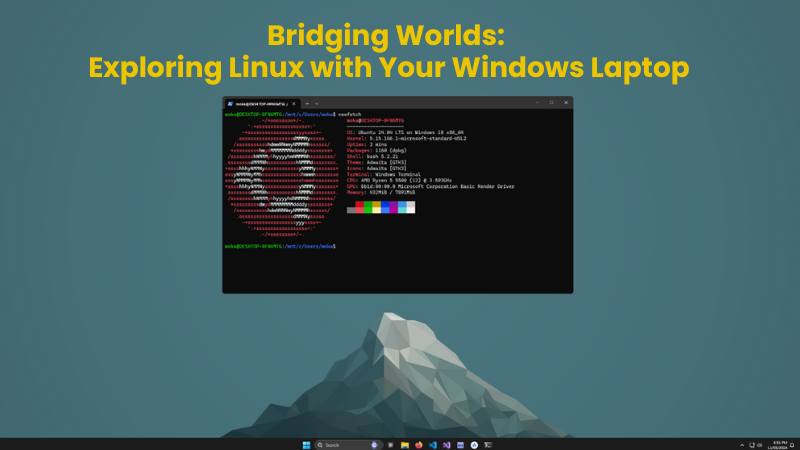
Bridging Worlds: Exploring Linux with Your Windows Laptop
Highlights
- Authored by Sachh Moka, Tech Research Lead, ACS Qld Emerging Professionals Committee, explore how your can unleash dual-platform power and run Linux on Windows effortlessly with WSL for ultimate productivity.

Windows Subsystem for Linux, or WSL, is a Windows feature that allows you to run a complete GNU/Linux environment directly on Windows, unmodified and without the overhead of a traditional virtual machine or dual-boot setup [1]. In this article, I will share my journey from struggling with underpowered hardware to discovering Linux, and how WSL allowed me to integrate it with my current Windows workflow. I’ll also explain why Linux is a valuable skill to learn, and how Windows users can use WSL to further explore it.
Background
As a highschooler, I didn’t have a powerful computer. My first machine had an AMD E2-9000e (one of the slowest laptop processors commercially available at the time) and 4 GB of RAM. In 2019, I struggled to run Windows, let alone the one game my mother let me purchase on Steam. This led me down a rabbit hole of attempting to speed up the operating system via different tricks.
Once I received my second laptop, with a slightly more powerful AMD A9 9425 and 8 gigs of RAM, I decided to continue this research in optimizing Windows. Unfortunately, in my attempts to speed up Windows on my machine, I ended up running it into the ground. Word to the wise: do not try running random scripts on any operating system, especially if you DON’T understand what they do.
Fed up with Windows, I borrowed my dorm mate’s flash drive and decided to install Xubuntu 18.04 on this laptop. After a couple of days, I was able to use it perfectly. Using it for the rest of the year, I ended up with the highest grades of my high school study.
Once I came into university, unfortunately, I had to revert to Windows. Certain software that I needed for my degree was not supported on Linux and attempting to run said software with emulation layers like Wine often broke other parts of my Linux Mint machine. So, I ended up crawling back. My heart, however, was still stuck on using Linux.
WSL came in and changed everything. It allowed me to run Linux inside Windows. During my break, I experimented around to see what all I could do with it, and I was pleasantly surprised by its versatility and performance. Setting up was as easy as following the documentation [2], and I was able to run my favourite Linux tools and commands seamlessly alongside my Windows applications.
Real-World Use Cases
My biggest use of WSL personally is in learning Linux specific skills that are essential to IT, specifically the bash terminal and programming. I’ve personally found it easier to work with packages and compilers in Linux when compared to Windows. Thanks to the superior package manager support in Linux, I have been able to hit the ground running much faster in my programming endeavours.
Linux is an incredibly valuable skill to learn in the world of IT [3]. It is used in administration, network engineering, software development, cybersecurity, etc. Most servers and supercomputers run Linux. Knowing how to use Linux opens the door to a ton of opportunities in technology.
For students looking to experiment with a Unix like operating system without wanting to wipe their current Windows system or spend a lot of money on a Mac computer, WSL in my opinion offers a uniquely implemented subsystem that serves as an effective introduction to Linux, Unix and that whole world.
One notable example is of WSL’s use in the real world is in EA’s Frostbite game engine [4]. Developers can use WSL to target server-related code for Linux builds of the engine directly from their Windows development environment. This reduces the complexity and overhead associated with managing separate systems for development and deployment.
Conclusion
WSL provides a fantastic way for users to experience the power and flexibility of Linux while retaining the familiarity and compatibility of Windows. For anyone interested in Linux, WSL offers a low-risk, high-reward opportunity to explore and utilize the strengths of both operating systems. Whether you're a developer, a system administrator, or just a tech enthusiast, WSL opens a world of possibilities. So why not get started today?
Sources:
1. What is Windows Subsystem for Linux
3. How to Learn Linux for Your Career: A Beginner's Guide
4. Electronic Arts and Visual Studio’s Linux Support
Written by Sachh Moka, Tech Research Lead, ACS QLD Emerging Professionals Committee
